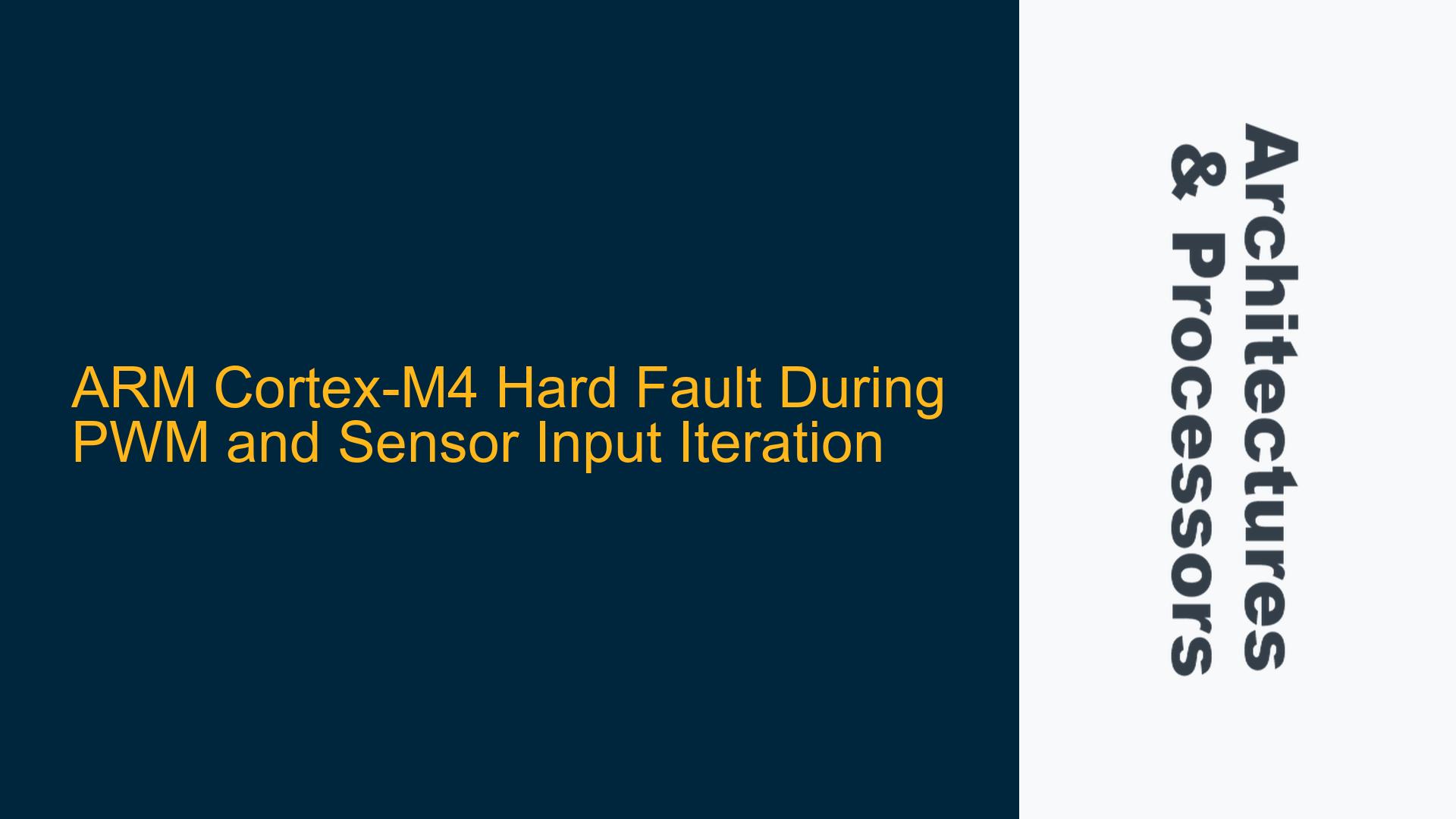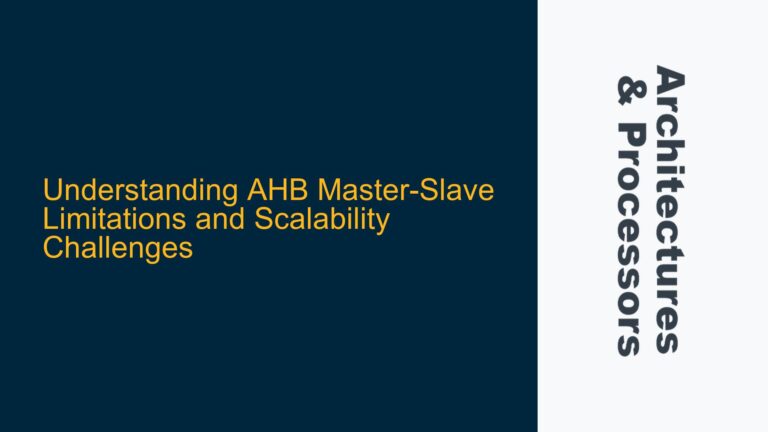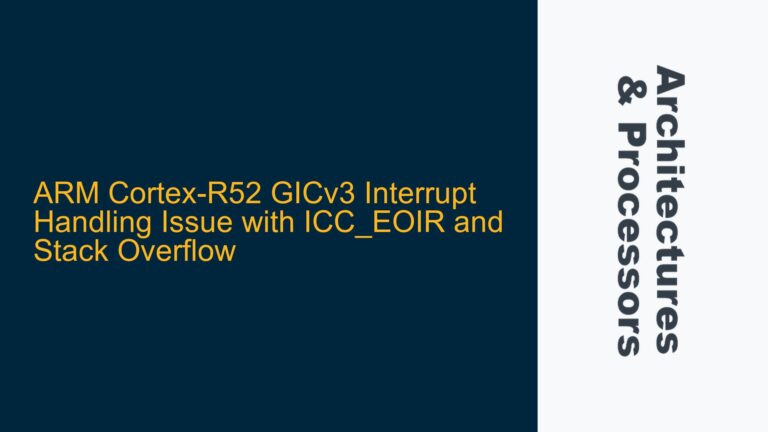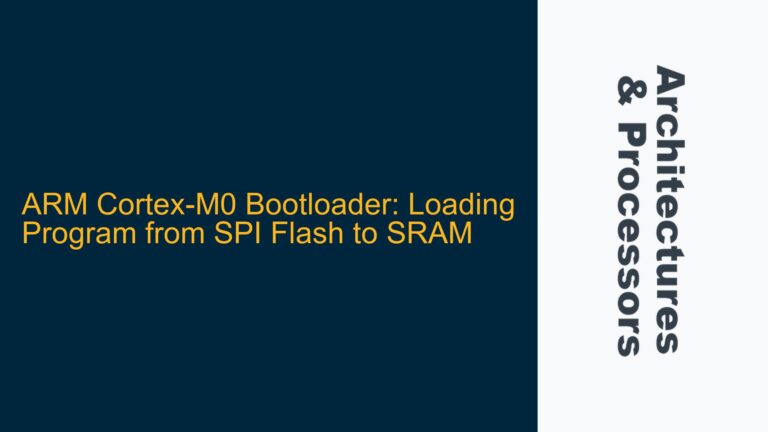ARM Cortex-M4 Hard Fault During PWM and Sensor Input Iteration
The issue described involves an ARM Cortex-M4 microcontroller (specifically the Tiva C series) entering a Hard Fault state during the second iteration of a loop that reads sensor input from GPIO Port B and generates PWM signals on GPIO Port F. The program operates correctly during the first iteration but fails upon subsequent iterations, indicating a potential issue with resource management, peripheral configuration, or memory access. Notably, the program runs without fault when PWM generation is omitted, suggesting that the PWM configuration or its interaction with other system components is a critical factor in the fault.
Hard Faults on ARM Cortex-M processors typically occur due to invalid memory accesses, illegal instruction execution, or improper handling of exceptions. In this case, the fault is triggered specifically when PWM signals are involved, which points to a potential misconfiguration of the PWM peripheral, a memory corruption issue, or an interrupt-related problem. The Cortex-M4’s Hard Fault handler can provide valuable diagnostic information, such as the Program Counter (PC), Link Register (LR), and Stack Pointer (SP) at the time of the fault, which can be used to pinpoint the root cause.
The problem is further complicated by the fact that the system operates correctly in the absence of PWM signals, indicating that the fault is not caused by the sensor input logic alone. This suggests that the PWM peripheral’s configuration or its interaction with other system components (such as interrupts or DMA) is the likely culprit. The following sections will explore the possible causes and provide detailed troubleshooting steps to resolve the issue.
PWM Peripheral Misconfiguration and Memory Access Violations
One of the most common causes of Hard Faults in ARM Cortex-M systems is improper peripheral configuration, particularly when dealing with complex peripherals like PWM modules. The Tiva C series microcontrollers use a sophisticated PWM module that requires precise configuration of registers such as the PWM Control Register (PWMCTL), PWM Generator Control Register (PWMGEN), and PWM Load Register (PWMLOAD). Misconfiguring these registers can lead to undefined behavior, including memory access violations or illegal instruction execution.
Another potential cause is memory access violations, which can occur if the program attempts to read from or write to an invalid memory address. This can happen if the stack overflows, if a pointer is dereferenced incorrectly, or if the memory map is not properly configured. In the context of PWM generation, memory access violations can occur if the PWM module is configured to use a buffer in memory that is not properly allocated or if the buffer is overwritten by another part of the program.
Interrupt-related issues can also lead to Hard Faults. If the PWM module is configured to generate interrupts, and the interrupt service routine (ISR) is not properly implemented, the system may enter an inconsistent state. For example, if the ISR does not clear the interrupt flag, the system may continuously enter the ISR, leading to a stack overflow or other resource exhaustion. Additionally, if the ISR attempts to access a resource that is already in use by the main program, a race condition or deadlock may occur, resulting in a Hard Fault.
Finally, the issue could be related to the interaction between the PWM module and other peripherals or system components. For example, if the PWM module is configured to use a clock source that is not properly enabled or if the PWM signals are routed to pins that are not properly configured, the system may enter an undefined state. Similarly, if the PWM module is configured to use DMA, and the DMA controller is not properly configured, memory access violations or other errors may occur.
Debugging Hard Faults and Resolving PWM Configuration Issues
To diagnose and resolve the Hard Fault issue, the following steps should be taken:
-
Capture Hard Fault Diagnostic Information: When a Hard Fault occurs, the Cortex-M4 processor stores critical diagnostic information in registers such as the Hard Fault Status Register (HFSR), Program Counter (PC), Link Register (LR), and Stack Pointer (SP). This information can be used to determine the cause of the fault. For example, the HFSR can indicate whether the fault was caused by a memory access violation, an illegal instruction, or an exception escalation. The PC and LR can be used to identify the exact location in the code where the fault occurred.
-
Inspect PWM Configuration Registers: Verify that the PWM module is properly configured by inspecting the relevant registers. Ensure that the PWM Control Register (PWMCTL) is set to enable the PWM module and that the PWM Generator Control Register (PWMGEN) is configured to generate the desired PWM waveform. Check the PWM Load Register (PWMLOAD) to ensure that the period of the PWM signal is correctly set. Additionally, verify that the PWM output pins are properly configured in the GPIO registers.
-
Check Memory Allocation and Access: Ensure that any buffers used by the PWM module are properly allocated and that they are not overwritten by other parts of the program. Use a memory protection unit (MPU) if available to prevent unauthorized access to critical memory regions. If the PWM module is configured to use DMA, verify that the DMA controller is properly configured and that the DMA buffer is correctly allocated.
-
Review Interrupt Configuration: If the PWM module is configured to generate interrupts, ensure that the interrupt service routine (ISR) is properly implemented. Verify that the ISR clears the interrupt flag and that it does not attempt to access resources that are already in use by the main program. Use priority levels to prevent interrupt nesting and ensure that the system can handle interrupts in a timely manner.
-
Test with Minimal Configuration: To isolate the issue, test the program with a minimal configuration that includes only the PWM module and the sensor input logic. Gradually add additional components and features to identify the specific configuration or interaction that triggers the Hard Fault.
-
Use Debugging Tools: Utilize debugging tools such as breakpoints, watchpoints, and trace capabilities to monitor the program’s execution and identify the exact point at which the fault occurs. Use a logic analyzer or oscilloscope to verify the PWM signals and ensure that they are being generated correctly.
-
Consult Documentation and Community Resources: Refer to the Tiva C series microcontroller documentation for detailed information on the PWM module and its configuration. Additionally, consult community forums and resources for insights and solutions from other developers who have encountered similar issues.
By following these steps, the root cause of the Hard Fault can be identified and resolved, allowing the program to operate correctly with both sensor input and PWM output. The key is to systematically eliminate potential causes and verify each component of the system to ensure that it is functioning as intended.
Implementing Robust PWM and Sensor Integration
Once the root cause of the Hard Fault has been identified and resolved, it is important to implement robust practices to prevent similar issues in the future. This includes:
-
Proper Initialization and Configuration: Ensure that all peripherals, including the PWM module and GPIO ports, are properly initialized and configured before they are used. Use a consistent initialization sequence and verify that all registers are set to their correct values.
-
Error Handling and Recovery: Implement error handling and recovery mechanisms to detect and respond to errors in a controlled manner. For example, if a memory access violation is detected, the program should log the error and attempt to recover rather than entering a Hard Fault state.
-
Resource Management: Carefully manage system resources such as memory, interrupts, and peripherals to prevent conflicts and ensure that the system operates reliably. Use techniques such as resource locking and priority management to prevent race conditions and deadlocks.
-
Testing and Validation: Thoroughly test the program under various conditions to ensure that it operates correctly and reliably. Use automated testing tools and techniques to identify and address potential issues before they occur in the field.
-
Documentation and Maintenance: Maintain detailed documentation of the program’s design, implementation, and configuration to facilitate troubleshooting and maintenance. Regularly review and update the documentation to reflect changes and improvements to the system.
By following these practices, the system can be made more robust and reliable, reducing the likelihood of Hard Faults and other issues. The key is to approach the problem systematically and to use the tools and techniques available to diagnose and resolve issues effectively.






